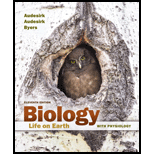
Concept explainers
Which of the following is/are found only in prokaryotic cells?
- a. plasmids
- b. a cytoskeleton
- c. mitochondria
- d. ribosomes
Introduction:
Prokaryotic cells are the cells that do not contain a true nucleus or other cell organelles. All the unicellular organisms are the prokaryotes such as bacteria and archaea. Prokaryotic cells have nucleoid region instead of a true nucleus. Unlike eukaryotic cells, they have a cell wall. Prokaryotic cells are usually 0.1 to 5 micrometers in size. They have a large surface area because they are small in sizes, that makes them obtain a large amount of nutrients via plasma membrane.
Answer to Problem 1MC
Correct answer:
Plasmids are found only in prokaryotic cells. Therefore, option (a) is correct.
Option (a) is given as “plasmids”.
Explanation of Solution
Justify reasons for the correct statement:
Plasmids are the autonomously replicating, double-stranded, extra-chromosomal DNA which is present mostly in the prokaryotic cells. However, sometimes they are also present in archaea and eukaryotes.
Hence, option (a) is correct.
Justify reasons for the incorrect statements:
Option (b) is given as “a cytoskeleton”.
A cytoskeleton is the complex network of protein filaments and tubules in the cytoplasm. It is present in all forms of cells, that is prokaryotic, eukaryotic or archaea. Hence, it is a wrong answer.
Option (c) is given as “mitochondria”.
Mitochondria is a membrane-bound cell organelle which is involved in the ATP production and it is exclusively found in the eukaryotic cells. Hence, it is a wrong answer.
Option (d) is given as “ribosomes”.
A ribosome is responsible for the protein synthesis, which is present in both prokaryotic and eukaryotic cells. Hence, it is a wrong answer.
Hence, options (b), (c), and (d). are incorrect.
Hence, plasmids are found only in prokaryotic cells
Want to see more full solutions like this?
Chapter 4 Solutions
Biology: Life on Earth with Physiology (11th Edition)
- Other than oil and alcohol, are there other liquids you could compare to water (that are liquid at room temperature)? How is water unique compared to these other liquids? What follow-up experiment would you like to do, and how would you relate it to your life?arrow_forwardSelection of Traits What adaptations do scavengers have for locating and feeding on prey? What adaptations do predators have for capturing and consuming prey?arrow_forwardCompetition Between Species What natural processes limit populations from growing too large? What are some resources organisms can compete over in their natural habitat?arrow_forward
- Species Interactions Explain how predators, prey and scavengers interact. Explain whether predators and scavengers are necessary or beneficial for an ecosystem.arrow_forwardmagine that you are conducting research on fruit type and seed dispersal. You submitted a paper to a peer-reviewed journal that addresses the factors that impact fruit type and seed dispersal mechanisms in plants of Central America. The editor of the journal communicates that your paper may be published if you make ‘minor revisions’ to the document. Describe two characteristics that you would expect in seeds that are dispersed by the wind. Contrast this with what you would expect for seeds that are gathered, buried or eaten by animals, and explain why they are different. (Editor’s note: Providing this information in your discussion will help readers to consider the significance of the research).arrow_forwardWhat is the difference between Uniporters, Symporters and Antiporters? Which of these are examples of active transport?arrow_forward
- What are Amyloid Fibrils? What biological functions are these known to perform?arrow_forwardHow do histamine and prostaglandins help in the mobilization of leukocytes to an injury site? What are chemotactic factors? How do they affect inflammation process?arrow_forwardCompare and contrast neutrophils and macrophages. Describe two ways they are different and two ways they are similar.arrow_forward

 Concepts of BiologyBiologyISBN:9781938168116Author:Samantha Fowler, Rebecca Roush, James WisePublisher:OpenStax College
Concepts of BiologyBiologyISBN:9781938168116Author:Samantha Fowler, Rebecca Roush, James WisePublisher:OpenStax College Comprehensive Medical Assisting: Administrative a...NursingISBN:9781305964792Author:Wilburta Q. Lindh, Carol D. Tamparo, Barbara M. Dahl, Julie Morris, Cindy CorreaPublisher:Cengage Learning
Comprehensive Medical Assisting: Administrative a...NursingISBN:9781305964792Author:Wilburta Q. Lindh, Carol D. Tamparo, Barbara M. Dahl, Julie Morris, Cindy CorreaPublisher:Cengage Learning





